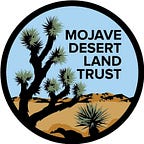Women look to the dark skies for data
By Mary Cook-Rhyne, MDLT Education Coordinator
Have you ever looked up at the nighttime sky and marveled at its vastness? I have and continue to because it is incredible. Yet, the stars are becoming harder and harder to see in populated areas.
Hi, Mary Cook-Rhyne here. I am the Education Coordinator at MDLT and the program manager for the Women in Science Discovering Our Mojave (WISDOM) program. Today I’d like to introduce you to the Dark Night Sky Measurement Project. For this project, interns have begun monitoring the night sky quality in the western portion of Mojave Trails National Monument.
Mojave Trails National Monument is located between Needles and Barstow, California. The monument sits between the I15 and the I40, wrapping around the Mojave National Preserve in a U-shape. It spans a whopping 1.6 million acres and contains natural features like riparian areas, rugged mountains, open salt flats, sand dunes, wilderness areas, and beautiful open vistas. There are multiple significant cultural and historic sites to visit in the monument. It’s called Mojave Trails National Monument for a good reason. Sections of historic Route 66 run through the southern portion. You can visit Roy’s Café in Amboy or Goffs out near Needles to drive along sections of the route. Running through Afton Canyon is the Mojave Road, the Spanish Trail, and significant Native American trade routes. If you’ve never visited the monument, I highly encourage you to get out and visit; safely and responsibly, of course!
I’m excited to introduce you to our interns who have joined the Night Sky team, driving throughout the monument, at night, to gather data.
Elizabeth Paige is an undergraduate at the College of the Desert in Palm Desert. She is working toward her degree in Conservation of Natural Resources. She is a lifelong resident of the Coachella Valley, a desert naturalist, and a Cahuilla native. She is passionate about cultural preservation throughout California. After graduation she wants to share her passion, engaging with local Indigenous communities to better educate a new generation of scientists interested in environmental studies and ecosystem management.
Karina Jimenez grew up in the San Fernando Valley. She is working toward her degree in Geography and minoring in Geology at California State University of Northridge. She plans to become an environmental scientist and work for the National Park Service after graduating from college.
Victoria Reiser is in her senior year at the University of Arizona, majoring in Sustainability with a focus on sustainable ecosystems. She was born and raised in the Morongo Basin and loves to hike on public lands including Mojave Trails National Monument. Victoria hopes to work within environmental sustainability in the future.
WISDOM aims to help engage women in STEM fields by gaining knowledge and conducting scientific research, both in the field and in the office. According to 2019 reports from the US Bureau of Labor Statistics, women comprise only 28.8% of the workforce employed in the scientific fields, though they make up 57.1% of the total workforce.
The long-term goal of WISDOM is to increase understanding of not only environmental science and land management issues in the Mojave Desert, but to also provide women with opportunities to conduct that research. The program fosters an environment of mentorship and career exploration by connecting female students with researchers and professionals, helping to develop the next generation of scientists.
The dark night sky survey project began in September. On our first overnight we met at MDLT’s HQ in Joshua Tree, setting out for the Sheephole Wilderness. We arrived at our data collection spot an hour after sunset. That first location ended up being our brightest point, measuring 22.25 lumens.
Besides collecting scientific data on the dark nights, we also get to take the opportunity to make bonus (non-scientific) observations of local wildlife when we take our blacklights out and look for scorpions. Not only is it fun to look for scorpions but, it also helps us stay safe when walking around at night
We continued from there, driving to Amboy Crater, Bagdad, Siberia, Ragtown, Pisgah Crater, Crucero, and Afton Canyon. When we stop at each location, we use Citizen Science apps and a Sky Quality Meter (SQM) to gather data.
Once we completed our measurement collections at the eight locations, we set up camp and went to sleep in Afton Canyon campground. At the time of our first overnight there was a Stage III fire ban, so we had cold coffee (or tea) and breakfast. Afton Canyon is where another internship program has been tracking bighorn sheep and tamarisk beetles.
Our hope for this project is to help the Bureau of Land Management get Mojave Trails National Monument designated as a Dark Sky Sanctuary through the International Dark Sky Association.
The designation would mean protection and conservation of the area’s dark night skies, while also allowing for education about their importance for flora and fauna. We will be able to empower others to become conservationists and Citizen Scientists of the land (and sky); and not just during the day.
The designation will promote greater visitation, and bring the associated benefits of tourism to this region.
We are currently preparing for our next data collection night. MDLT will keep you updated as this project progresses. Also be on the lookout for stories written by the interns themselves.
This internship program is made possible through funding from Southern California Edison International.
For the Night Sky project, we are participating in the Globe at Night and Loss of the Night citizen science programs. Why not join in? Our collective information can help our global community study light pollution around the world. For more advice on becoming a citizen science, watch our video.
